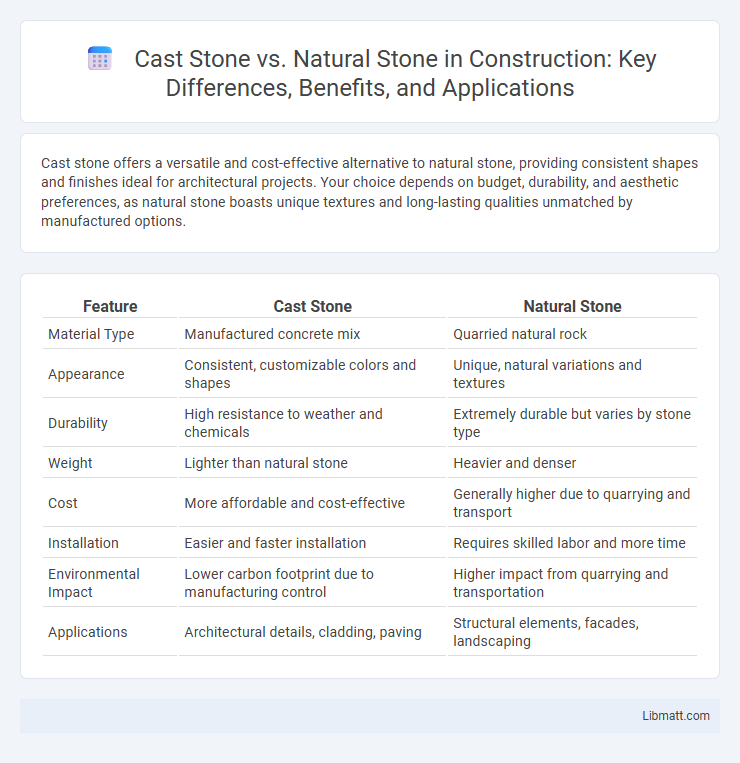Cast stone offers a versatile and cost-effective alternative to natural stone, providing consistent shapes and finishes ideal for architectural projects. Your choice depends on budget, durability, and aesthetic preferences, as natural stone boasts unique textures and long-lasting qualities unmatched by manufactured options.
Table of Comparison
| Feature | Cast Stone | Natural Stone |
|---|---|---|
| Material Type | Manufactured concrete mix | Quarried natural rock |
| Appearance | Consistent, customizable colors and shapes | Unique, natural variations and textures |
| Durability | High resistance to weather and chemicals | Extremely durable but varies by stone type |
| Weight | Lighter than natural stone | Heavier and denser |
| Cost | More affordable and cost-effective | Generally higher due to quarrying and transport |
| Installation | Easier and faster installation | Requires skilled labor and more time |
| Environmental Impact | Lower carbon footprint due to manufacturing control | Higher impact from quarrying and transportation |
| Applications | Architectural details, cladding, paving | Structural elements, facades, landscaping |
Introduction to Cast Stone and Natural Stone
Cast stone is a manufactured masonry product designed to simulate natural cut stone, produced from a mix of cement, aggregates, and pigments for consistent size, shape, and color. Natural stone, such as granite, limestone, or marble, is quarried directly from the earth, offering unique textures, patterns, and durability due to its geological formation. Both materials serve architectural and landscaping purposes, but cast stone provides cost-effective versatility while natural stone delivers unparalleled authenticity and strength.
Composition and Manufacturing Processes
Cast stone is a manufactured product composed primarily of cement, fine and coarse aggregates, and mineral pigments, designed to mimic natural stone's appearance and texture. Natural stone, such as granite or limestone, forms through geological processes over millions of years, resulting in unique mineral compositions and structural characteristics. Understanding these differences in composition and manufacturing processes helps you select the most suitable material for your construction or design needs.
Appearance and Aesthetic Differences
Cast stone offers consistent color, texture, and shape, providing a uniform appearance ideal for modern architectural designs, while natural stone features unique variations in hue and grain that create a more organic and timeless look. The engineered composition of cast stone allows for precise replication of natural stone patterns, but it often lacks the depth and irregularities that contribute to the natural stone's character. Natural stone's inherent aesthetic diversity enhances visual interest and authenticity, making it preferable for projects emphasizing traditional or rustic styles.
Durability and Longevity Comparison
Cast stone offers consistent durability due to its engineered composition, resisting weathering, chipping, and cracking more effectively than many natural stones. Natural stone, such as granite or limestone, provides exceptional longevity when properly maintained but may be prone to erosion and staining over time due to its porous nature. Both materials demonstrate substantial lifespan potential, yet cast stone's controlled manufacturing process often results in enhanced uniformity and resilience under harsh environmental conditions.
Installation and Workability
Cast stone offers enhanced workability due to its uniform shape and size, making installation faster and more precise compared to natural stone, which often requires skilled labor for cutting and fitting irregular pieces. The lighter weight of cast stone reduces handling difficulties and minimizes structural load, streamlining the construction process. Natural stone provides superior durability but demands more time and expertise during installation, increasing labor costs and project timelines.
Environmental Impact and Sustainability
Cast stone generally has a lower environmental impact than natural stone due to its manufactured process allowing for the use of recycled materials and reduced quarrying. Natural stone extraction involves significant habitat disruption and energy-intensive quarrying, contributing to higher carbon emissions. You can enhance your project's sustainability by choosing cast stone, which offers durability with less strain on natural resources.
Cost Analysis: Cast Stone vs Natural Stone
Cast stone offers a cost-effective alternative to natural stone, typically reducing expenses by 30-50% due to lower material and installation costs. Natural stone demands higher investment because of quarrying, transportation, and intricate craftsmanship required for each piece. You can achieve the aesthetic appeal of natural stone with cast stone while optimizing your budget, especially for large-scale architectural projects.
Maintenance Requirements and Lifespan
Cast stone requires less maintenance than natural stone due to its uniform composition and resistance to weathering, making it easier to clean and less prone to cracking or chipping. Natural stone, while highly durable and able to last centuries, often demands regular sealing and careful upkeep to prevent staining, erosion, or moss growth. Your choice between the two should consider the balance between maintenance effort and desired longevity in your specific application.
Common Applications and Use Cases
Cast stone is widely used for architectural details, such as window surrounds, balustrades, and garden ornaments, due to its versatility and cost-effectiveness compared to natural stone. Natural stone, prized for its durability and unique texture, is commonly chosen for structural elements, countertops, flooring, and exterior cladding in high-end residential and commercial projects. Your selection depends on the desired aesthetic, budget, and specific functional requirements of the application.
Choosing the Right Material for Your Project
Cast stone offers versatility, cost-effectiveness, and uniformity, making it ideal for large-scale projects requiring consistent texture and color. Natural stone provides unique aesthetic appeal and enhanced durability, suitable for high-end designs where authenticity and long-lasting quality are paramount. Assessing factors like budget, project scale, desired finish, and maintenance needs ensures optimal material selection for your construction or landscaping project.
Cast stone vs natural stone Infographic

 libmatt.com
libmatt.com